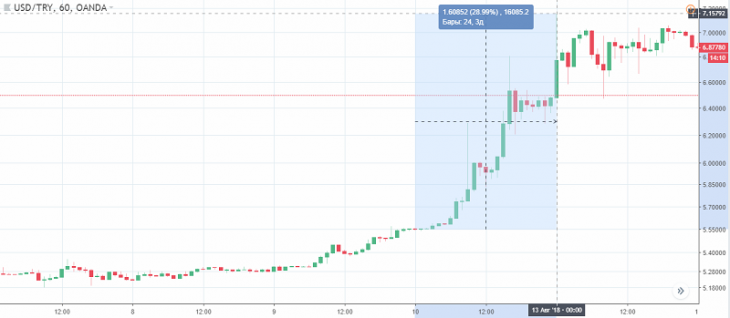
Collapse of the Turkish lira. A threat to the market!
On Friday, August 10, the Turkish lira collapsed against the US dollar. As a result, this decline has caused a wave of risks associated with investment in the economy of Turkey and emerging markets.

USD/TRY chart
In the figure above, the chart of the USD/TRY currency pair movement, where for trading on Friday, August 10 and at the opening of trading on Monday, the Turkish lira weakened by 29% or 16,000 pips.
This movement and its consequences in the foreign exchange market were dubbed a “blood bath”. As the lyre crash led to a decline in the emerging markets currencies, and after it the currencies of developed markets collapsed. But first things first.
The reasons for the collapse of the Turkish lira
The main reason for the collapse of the Turkish lira was the arrest of the American pastor in Turkey, which is associated with Turkey’s reaction when USA doubled the tariffs on Turkish metals, mainly steel and aluminum. So, one can call the Turkish crisis and its consequences the first non-obvious impact of the Trump trade war.
Risks for the international market
Information that the ECB representatives are concerned about the investments of a number of European banks in the Turkish economy and are now in a difficult situation added petrol in the Turkish crisis. It became a kind of driver of the growth of risks in the world market and the spread of the Turkish crisis from emerging markets to markets with a market economy.
Almost all European markets, and especially the euro turned out under pressure with the growth of risks, euro accelerated the decline against safe harbor currencies: the Japanese yen and the Swiss franc, and in particular against the US dollar. Well, the collapse of the euro was also followed by a decline in other international currencies, mainly in favor of the US dollar.
As a result, the US dollar index overcame such significant resistance levels: 95.80-50 and 96.00, which at the start of last week seemed very significant and can only be broken through by the end of August.
What’s going to happen next?
To stabilize the Turkish lira, the Central Bank of Turkey will have to resort to an aggressive policy of raising rates or to control foreign investments, which can also have a very negative impact on the general mood of the market. But they will have less influence than it was before, but only if there are no political games around it.
This situation remains negative for the euro from either side. And if the market manages to win back the losses of the euro on renewed optimism, but for this optimism there is no reason. This situation points to the fragility of both the European economy and the world as a whole. Not to mention the fact that the US trade war has shifted from local economic threats to global ones.
Anton Hanzenko